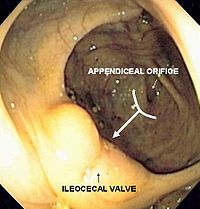
Bow and arrow sign
Encyclopedia

Endoscopy
Endoscopy means looking inside and typically refers to looking inside the body for medical reasons using an endoscope , an instrument used to examine the interior of a hollow organ or cavity of the body. Unlike most other medical imaging devices, endoscopes are inserted directly into the organ...
sign for determining the location of the ileocecal valve
Ileocecal valve
The ileocecal valve, or ileocaecal valve, is of a bilabial papilla structure with physiological sphincter muscle situated at the junction of the small intestine and the large intestine, with recent evidence indicating an anatomical sphincter may also be present in humans) Its critical function is...
during colonoscopy
Colonoscopy
Colonoscopy is the endoscopic examination of the large bowel and the distal part of the small bowel with a CCD camera or a fiber optic camera on a flexible tube passed through the anus. It may provide a visual diagnosis and grants the opportunity for biopsy or removal of suspected...
. Identifying the ileocecal valve in a colonoscopy is important, as it indicates that the entire colon
Colon (anatomy)
The colon is the last part of the digestive system in most vertebrates; it extracts water and salt from solid wastes before they are eliminated from the body, and is the site in which flora-aided fermentation of unabsorbed material occurs. Unlike the small intestine, the colon does not play a...
has been visualized.
The identifiable landmarks in the cecum
Cecum
The cecum or caecum is a pouch, connecting the ileum with the ascending colon of the large intestine. It is separated from the ileum by the ileocecal valve or Bauhin's valve, and is considered to be the beginning of the large intestine. It is also separated from the colon by the cecocolic...
are the appendiceal orifice
Vermiform appendix
The appendix is a blind-ended tube connected to the cecum , from which it develops embryologically. The cecum is a pouchlike structure of the colon...
-- which is a curvilinear indent indicating the location of the appendix from the lumen of the bowel, and the ileocecal valve, which appears as a puckering in the most distal fold of the cecum.
The bow and arrow sign uses the curve of the appendiceal orifice to point toward the direction of the ileocecal valve, as if it were a bow
Bow (weapon)
The bow and arrow is a projectile weapon system that predates recorded history and is common to most cultures.-Description:A bow is a flexible arc that shoots aerodynamic projectiles by means of elastic energy. Essentially, the bow is a form of spring powered by a string or cord...
guiding an arrow
Arrow
An arrow is a shafted projectile that is shot with a bow. It predates recorded history and is common to most cultures.An arrow usually consists of a shaft with an arrowhead attached to the front end, with fletchings and a nock at the other.- History:...
. The colonoscope
Colonoscopy
Colonoscopy is the endoscopic examination of the large bowel and the distal part of the small bowel with a CCD camera or a fiber optic camera on a flexible tube passed through the anus. It may provide a visual diagnosis and grants the opportunity for biopsy or removal of suspected...
can be passed in this direction in order to enter the terminal ileum
Terminal ileum
The terminal ileum is the most distal part of the small intestine. It connects to the cecum, the pouch between the small and the large intestine, via the ileocecal valve.-Pathology of the terminal ileum:...
. This is used as one of two identifiable landmarks of the colon (the other being the anus
Anus
The anus is an opening at the opposite end of an animal's digestive tract from the mouth. Its function is to control the expulsion of feces, unwanted semi-solid matter produced during digestion, which, depending on the type of animal, may be one or more of: matter which the animal cannot digest,...
), and signifies that the entire colon has been visualized.

